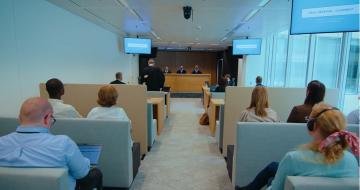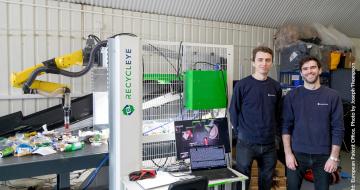The procedure for granting a Belgian patent is relatively simple because the patent is granted regardless of the outcome of the examination of the conditions of patentability. Indeed, the European Patent Office carries out research for any prior art of the invention. However, the outcome does not influence the grant of the patent. The research report is accompanied by a written opinion on the patentability of the invention, which is given for information purposes and is accessible to third parties in the patent application submitted for inspection. However, the applicant may make amendments to his patent application based on the results of the research report and the written opinion. But the amended claims may not contain characteristics that are not part of the original patent application, on which the research report was made and that are not part of the general inventive concept of the invention. They may also file written comments on the written opinion so that the patent application records his assessment of any issues relating to the patentability of his invention that may be raised in the written opinion.
Providing a written opinion during the grant procedure allows the applicant to have an accurate idea of the quality of his application and the risks of having his patent cancelled if he decides to continue the procedure. Third parties may also specifically assess the added value provided by the patent to the field of technology concerned by the invention and whether their activities are likely to infringe the protection thus conferred when the patent is granted. If the validity of the patent is subsequently contested, it will be up to the judge to decide.
It is advisable to file a Belgian patent application, if you are only considering exploiting your invention within Belgian territory.
The Belgian patent has other advantages. It can be used as a ‘first filing' on the basis of which it is possible to claim a 12-month right of priority to subsequently file a patent application in other countries. More information on the right of priority.
Filing a patent application
Where and how?
With the aim of applying for a patent, you must complete an application form (PDF, 632.89 KB) (French version) at the Office for Intellectual Property
Dutch version of the application form (PDF, 614.71 KB)
German version of the application form.
The application can also be filed electronically in a secure environment.
The application form can be submitted in person, by fax or by mail. For information on filing by mail or in person, please consult the "contact" page.
You can be represented by an expert (see the list of accredited patent attorneys).
Content of the Belgian application and the allocation of a filing date
The date on which IPObel receives the patent application is recorded in a report which also indicates the filing date. A filing date may be granted, if the following information is provided to the IPObel:
- an explicit or implicit indication that the elements are deemed to constitute a patent application;
- indications making it possible to identify the applicant and enabling IPObel to contact the applicant;
- a part which, at first glance, appears to be a description of the invention for which patent protection is applied for.
The filing date is decisive for assessing the novelty, and therefore for judging the priority between different patent applications. Both the Belgian and European patents are governed by the first-to-file principle, which means that the first applicant for a patent will be the patent holder, even if they are not the first to have invented the invention in question.
Following the granting of a filing date, the patent application must contain the following elements:
- a patent request form addressed to the competent Minister;
- the applicant's identification details;
- a description of the invention:
The invention must be described in the patent application in a sufficiently clear and complete manner so that a specialist in the same technical field can carry out the invention; - one or more claims:
These claims describe the subject matter for which protection is applied for. Although the description and possible drawings may help to interpret the claims, the claims alone will determine the scope of the patent granted.
If these claims are formulated too restrictively, the patent granted will be restrictive and this cannot be subsequently remedied. A poorly drafted claim can, therefore, lead to a very limited patent. It is advised to be assisted by a patent attorney! - possible drawings to which the description or the conclusions refer ;
The drawings are essential when they are necessary to understand the invention. - an abstract (summary) that will be used to communicate the patent information to third parties;
- where applicable, a reference to the geographical origin of the biological material from which the invention was developed, if known;
- the name of the inventor (or the inventor's request that they are not mentioned in the patent).
- The pages of patent application must be numbered in accordance with the circular of 13.08.2020 (PDF, 123.96 KB) (French version – Dutch version of the circular of 13.08.2020 (PDF, 115.63 KB) - German version of the circular of 13.08.2020)
Language of the request
In order to obtain a filing date, the explicit or implicit indication that the information transmitted to IPObel is intended to constitute a patent application and the indications making it possible to identify the applicant and enabling the Office to contact the applicant must be written in the national language (Dutch, French, German) prescribed in accordance with the laws on the use of languages in administrative matters.
On the other hand, the part which, at first glance, appears to be a description may be filed in any language, provided that a translation of that part into the national language prescribed in accordance with the laws on the use of languages in administrative matters is provided to the IPObel within three months of the date on which the IPObel received that part.
Automatic translate software is available for the public at the website of the European Patent Office. This allows for machine translations of patents using the esp@cenet database. The translation is purely informative, it has no legal value.
Other provisions relating to the use of language before IPObel
The language of the procedure, as well as the language used in the correspondence with IPObel, are the languages that must be used by the patent applicant or patent holder in accordance with the coordinated laws on the use of languages in administrative matters. This also applies if a patent agent acts in the name and on behalf of the patent applicant. The patent application and the related correspondence must be drafted taking into consideration the language of the person represented by the agent.
Regularisation
If the conditions for allocating a filing date are not met or if a requirement for the continuation of the procedure is not met, the applicant is notified by IPObel of this irregularity. The applicant has a period of three months, from the date of notification to regularise the situation. The filing date is then the date on which all the above conditions are met. If the application is not regularised by the end of the period prescribed by IPObel, it shall be deemed not to have been filed. In this case, IPObel will notify the applicant and provide the reasons.
If a requirement for the continuation of the procedure is not complied with (for example, if the patent application is incomplete or if the application fee has not been paid), IPObel will notify the applicant of this irregularity. The applicant has a period of three months from the date of notification to regularise the situation. A regularisation fee of 60 euros must be paid within the same period. If any of these two conditions are not met, the non-regularised patent application shall be deemed to have been withdrawn.
As long as the patent has not been granted, the applicant may also take the initiative to regularise their application without having been requested by IPObel.
Restoration
A procedure for the restoration of rights is available in the event that the applicant or patent holder has not complied with a time limit set to complete an action in a procedure before IPObel. Restoration applies in principle to all periods covered by the law for which non-compliance directly results in the loss of rights. When the request for restoration is granted, the legal consequences of non-compliance with the time limit shall be deemed not to have occurred. In other words, the patent is deemed never to have ceased having effect.
Please note, restoration is not available in certain situations. First of all, a restoration cannot be requested for the payment of the annual fees that become due as a result of the effects of a restoration procedure. Moreover, failure to comply with the time limit for regularisation of a patent application may not be the subject of a request for restoration either. Finally, restoration is not admissible for failure to comply with the three-month period from the date of notification by IPObel of an irregularity with regard to the conditions for representation before the IPObel.
Payment of filing fees
Proof of payment of the filing fee must arrive at the IPObel within one month of the patent request application.
Search for prior art
Within 13 months after the filing date (or the priority date if a right of priority is invoked), the applicant must pay the fees for the search for novelty. This search is carried out by the European Patent Office, which generates a search report and a written opinion on the other conditions for patentability.
The search for prior art and written opinion are not binding and do not provide a definitive guarantee as to the validity of the patent. Even if it appears that the invention is not new or that another condition of patentability is not met, a Belgian patent may nevertheless be granted on the invention. However, the judge before whom the validity of the patent may be contested is not bound by these documents. The definitive validity of the patent will, therefore, be decided only by legal proceedings, if necessary. Nonetheless, the search report and the written opinion play a useful informative role and allow the patent applicant to withdraw or amend their application.
There is an important difference here between the Belgian patent and the European patent. The latter implies that the European Patent Office may - following examination of compliance with the conditions for patentability - refuse to grant a patent, if these conditions are not fulfilled.
If the European Patent Office considers that a significant research on the state of the art cannot be carried out with regard to all or part of the invention claimed in the patent application, it will declare that such a research is impossible or will draw up, to the extent possible, a partial search report and a written opinion. This declaration will replace the search report and the written opinion in the patent application submitted to public inspection.
Filing a divisional application
The patent application may pertain to only one invention or a plurality of inventions – linked together in such a way that they form a single general inventive concept. This requirement of unity of invention is an international standard in patent law.
In the context of the procedure for granting the Belgian patent, the search report provided to the applicant may state that the invention for which the patent application is filed does not satisfy the requirement of unity of invention. In this case, the search report is drawn up for the parts of the application which pertain to the invention or a plurality of inventions stated in the first instance in the claims. The applicant must then, before the grant of the patent, either divide his application (into several so-called "divisional" applications) - and pay the fees due for these applications in the prescribed time limit (filing fee, search fee and the possible annuities) - or limit his patent application to a single invention or general inventive concept. The division or restriction of the application can be the consequence of the initiative of the applicant, or it can obey the notification of the search report in which IPObel invites him to this end. In both cases a division or restriction of the patent application is only possible until the grant of the patent. If the applicant does not restrict his application and does not submit a divisional application or applications, the granted patent will be limited to the claims for which the research report was drawn up.
Divisional applications retain the date of the initial application and, where applicable, the benefit of the right of priority. Once filed, any divisional application is treated as an independent patent application.
Publication of the patent application
IPObel makes patent applications (filed on or after 22/09/2014) available to the public after 18 months from the filing date or, where applicable, the date of priority . The automatic publication of patent applications is a measure aimed at increasing legal certainty and allows other economic operators to know that protection is being applied for an invention that concerns the sector of activity in which they may be active. However, the patent application will not be made available to the public, if it has been withdrawn or is deemed to have been withdrawn. If - in view of the progress of the procedure - the patent is ready for publication after 18 months, it will be granted and the patent application on which it is based will be included in the file submitted for public inspection.
Grant and publication of the patent
During the procedure before IPObel and as long as the patent has not been granted, the applicant may, on their own initiative, rectify errors of wording or transcription. Such rectification may only be accepted, if it is established that the patent applicant could clearly not have considered any other text than the one resulting from the rectification.
Once all formalities have been completed and subject to payment of the fees due, the patent is granted by ministerial order as soon as possible after the expiry of a period of 18 months from the filing date (or the priority date if a right of priority is claimed). The applicant may request that the patent be granted more quickly, if all the formalities are fulfilled. This may be useful, for example, if a patent infringement is committed shortly after a patent application is filed.
Consequently, the grant of a Belgian patent only requires compliance with formal obligations - including payment of the fees due - and in no way guarantees that the conditions for the validity of the patent are met.
The patent is listed in an official register, which can be consulted online. The complete patent and the application are also available for consultation as soon as the patent is granted. IPObel will also ensure a brief publication of the essential characteristics of the patents granted in the Bulletin of Patents.
The dossier for the granted patent includes all information and documents relating to the procedure for granting the patent, useful for informing the public, with the exception of documents which are excluded from inspection in order to safeguard the legitimate interests of natural or legal persons.
The patent enters into force on the day on which it is made available to the public (in principle on the day it is granted), or when published by IPObel. Prior to this publication, the holder of the patent application nevertheless has provisional protection. The provisional protection conferred by the patent application is determined by the claims which have been the subject of the publication of the patent application, or, where applicable, by the most recent claims filed with IPObel and, as the case may be, made available to the public or contained in the copy given to the third party who exploited the invention which is the subject of the patent application.


